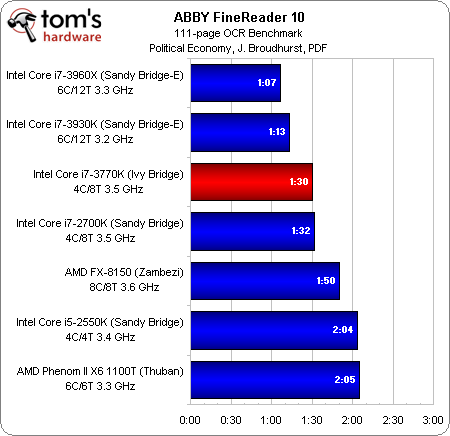Intel Core i7-3770K Review: A Small Step Up For Ivy Bridge
Benchmark Results: Productivity
The ongoing pattern seems consistent enough that I could probably get away without any analysis here at all. In a threaded title like FineReader, the six-core Sandy Bridge-E chips walk away with an advantage.
Behind them, quad-core Ivy and Sandy Bridge-based chips running at the same clock rate (Core i7-3770K and -2700K, more specifically) land a few seconds apart, but always with Ivy Bridge in the lead.
Meanwhile, AMD’s Phenom II and FX flagships seem content to do battle with Core i5-2550K. Though, in this case, the FX springs up into the lead ahead of Intel’s mainstream processor.
I typically don’t use Fritz in my processor launch stories, but I’ve received enough requests to reincorporate it that I’m including results in today’s piece.
Sandy Bridge-E clearly rules, while the IPC optimizations inherent to Ivy Bridge give it the slightest edge over Sandy Bridge at a given clock rate.
Aggressive threading allows FX-8150 to outpace Phenom II X6, as both AMD chips outrun Intel’s Core i5-2550K.
A demanding Google Chrome compile workload takes more than 30 minutes on three of today’s contenders. The two six-core Sandy Bridge-E-based parts get the job done in well under 20 minutes.
Get Tom's Hardware's best news and in-depth reviews, straight to your inbox.
Core i7-3770K and -2770K fall somewhere in between, separated by just 22 seconds.
Our PDF document creation is decidedly single-threaded. Naturally, then, Intel’s Ivy and Sandy Bridge architectures do particularly well, while the lower IPC of AMD’s designs cannot be overcome by clock rate.
The slight improvements in Ivy Bridge are enough to give Core i7-3770K a first-place finish. Intel’s two Sandy Bridge implementations follow closely behind.
Current page: Benchmark Results: Productivity
Prev Page Benchmark Results: Content Creation Next Page Benchmark Results: File Compression-
tecmo34 Nice Review Chris...Reply
Looking forward to the further information coming out this week on Ivy Bridge, as I was initially planning on buying Ivy Bridge, but now I might turn to Sandy Bridge-E -
jaquith Great and long waited review - Thanks Chris!Reply
Temps as expected are high on the IB, but better than early ES which is very good.
Those with their SB or SB-E (K/X) should be feeling good about now ;) -
xtremexx saw this just pop up on google, posted 1 min ago, anyway im probably going to update i have a core i3 2100 so this is pretty good.Reply -
ojas it's heeearrree!!!!! lol i though intel wan't launching it, been scouring the web for an hour for some mention.Reply
Now, time to read the review. :D -
zanny It gets higher temps at lower frequencies? What the hell did Intel break?Reply
I really wish they would introduce a gaming platform between their stupidly overpriced x79esque server platform and the integrated graphics chips they are pushing mainstream. 50% more transistors should be 30% or so more performance or a much smaller chip, but gamers get nothing out of Ivy Bridge. -
JAYDEEJOHN It makes sense Intel is making this its quickest ramp ever, as they see ARM on the horizon in today's changing market.Reply
They're using their process to get to places they'll need to get to in the future -
verbalizer OK after reading most of the review and definitely studying the charts;Reply
I have a few things on my mind.
1.) AMD - C'mon and get it together, you need to do better...2.) imagine if Intel made an i7-2660K or something like the i5-2550K they have now.
3.) SB-E is not for gaming (too highly priced...) compared to i7 or i5 Sandy Bridge
4.) Ivy Bridge runs hot.......
5.) IB average 3.7% faster than i7 SB and only 16% over i5 SB = not worth it
6.) AMD - C'mon and get it together, you need to do better...
(moderator edit..) -
Pezcore27 Good review.Reply
To me it shows 2 main things. 1) that Ivy didn't improve on Sandy Bridge as much as Intel was hoping it would, and 2) just how far behind AMD actually is... -
tmk221 It's a shame that this chip is marginally faster than 2700k. I guess it's all AMD fault. there is simply no pressure on Intel. Otherwise they would already moved to 8, 6, and 4 cores processors. Especially now when they have 4 cores under 77W.Reply
Yea yea I know most apps won't use 8 cores, but that's only because there was no 8 cores processors in past, not the other way around




